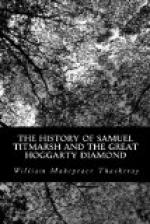“See,” thought I, “what I have gained by Aunt Hoggarty giving me a diamond-pin! What a lucky thing it is that she did not give me the money, as I hoped she would! Had I not had the pin—had I even taken it to any other person but Mr. Polonius, Lady Drum would never have noticed me; had Lady Drum never noticed me, Mr. Brough never would, and I never should have been third clerk of the West Diddlesex.”
I took heart at all this, and wrote off on the very evening of my appointment to my dearest Mary Smith, giving her warning that a “certain event,” for which one of us was longing very earnestly, might come off sooner than we had expected. And why not? Miss S.’s own fortune was 70_l_. a year, mine was 150_l_., and when we had 300_l_., we always vowed we would marry. “Ah!” thought I, “if I could but go to Somersetshire now, I might boldly walk up to old Smith’s door” (he was her grandfather, and a half-pay lieutenant of the navy), “I might knock at the knocker and see my beloved Mary in the parlour, and not be obliged to sneak behind hayricks on the look-out for her, or pelt stones at midnight at her window.”
My aunt, in a few days, wrote a pretty gracious reply to my letter. She had not determined, she said, as to the manner in which she should employ her three thousand pounds, but should take my offer into consideration; begging me to keep my shares open for a little while, until her mind was made up.
What, then, does Mr. Brough do? I learned afterwards, in the year 1830, when he and the West Diddlesex Association had disappeared altogether, how he had proceeded.
“Who are the attorneys at Slopperton?” says he to me in a careless way.
“Mr. Ruck, sir,” says I, “is the Tory solicitor, and Messrs. Hodge and Smithers the Liberals.” I knew them very well, for the fact is, before Mary Smith came to live in our parts, I was rather partial to Miss Hodge, and her great gold-coloured ringlets; but Mary came and soon put her nose out of joint, as the saying is.
“And you are of what politics?”
“Why, sir, we are Liberals.” I was rather ashamed of this, for Mr. Brough was an out-and-out Tory; but Hodge and Smithers is a most respectable firm. I brought up a packet from them to Hickson, Dixon, Paxton, and Jackson, our solicitors, who are their London correspondents.
Mr. Brough only said, “Oh, indeed!” and did not talk any further on the subject, but began admiring my diamond-pin very much.
“Titmarsh, my dear boy,” says he, “I have a young lady at Fulham who is worth seeing, I assure you, and who has heard so much about you from her father (for I like you, my boy, I don’t care to own it), that she is rather anxious to see you too. Suppose you come down to us for a week? Abednego will do your work.”
“Law, sir! you are very kind,” says I.
“Well, you shall come down; and I hope you will like my claret. But hark ye! I don’t think, my dear fellow, you are quite smart enough—quite well enough dressed. Do you understand me?”




